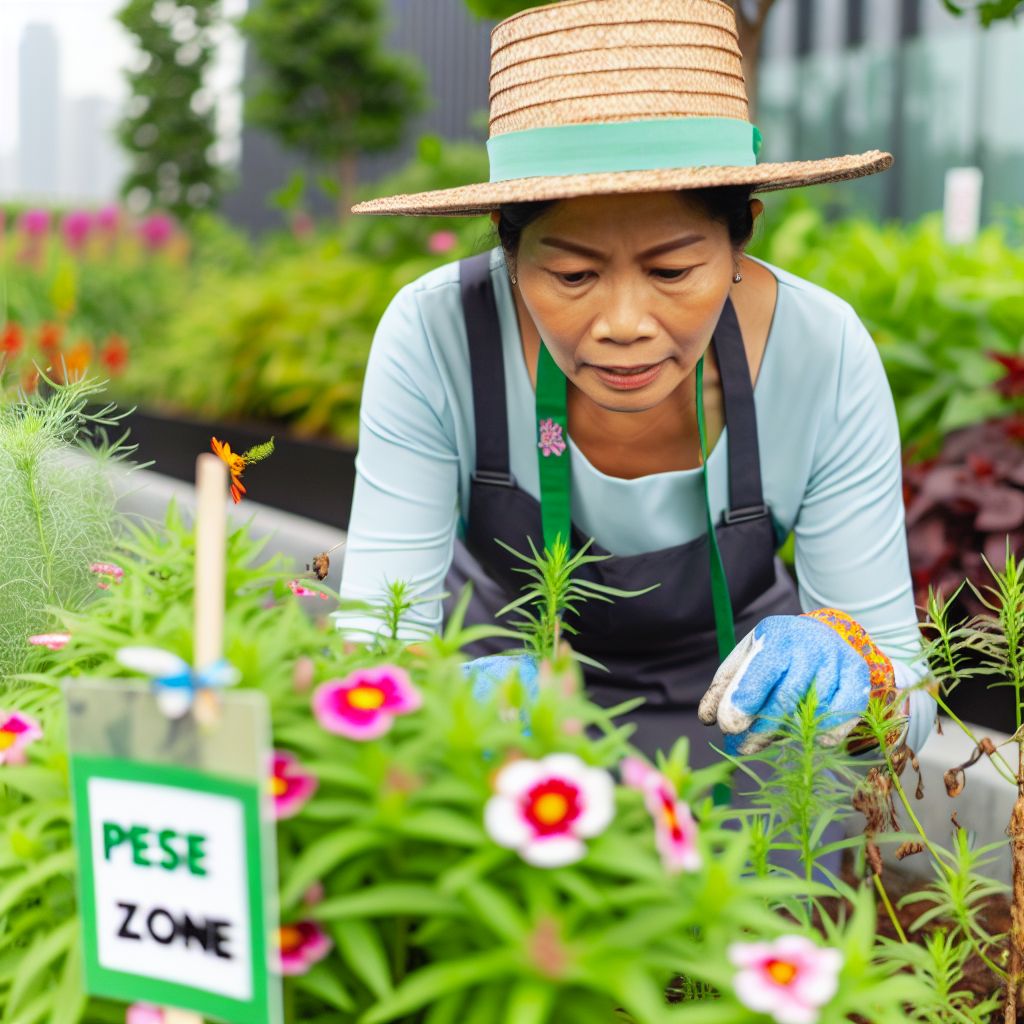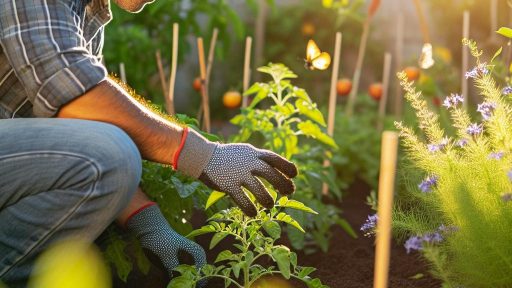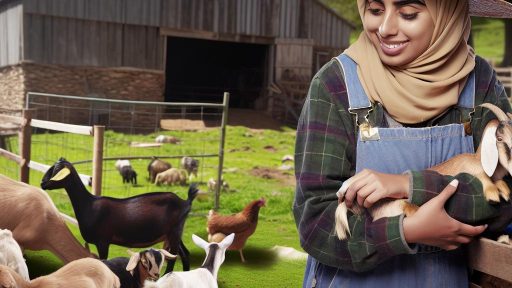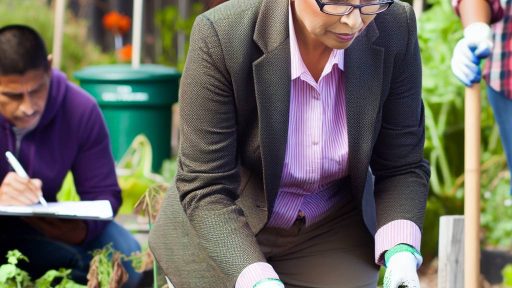Identifying Common Pests in Indoor Gardens
Common Indoor Pests
Identifying pests is crucial for maintaining healthy indoor gardens.
Common pests include aphids, spider mites, and whiteflies.
Each pest can cause significant damage if not addressed promptly.
Aphids often cluster on new growth, feeding on plant sap.
They can weaken plants and promote the spread of diseases.
Spider mites thrive in dry conditions and produce fine webbing.
They suck cell contents, leading to stippled leaves.
Whiteflies are small and resemble tiny moths.
They excrete honeydew, which attracts ants and fosters sooty mold.
Signs of Infestation
Recognizing signs of infestation helps with early intervention.
Look for yellowing leaves, wilting, or stunted growth.
Sticky residue on surfaces indicates the presence of pests.
Additionally, you might notice discolored spots on leaves.
Visible insects on plants suggest immediate action is necessary.
Frequent observations can prevent severe infestations.
Transform Your Agribusiness
Unlock your farm's potential with expert advice tailored to your needs. Get actionable steps that drive real results.
Get StartedMonitoring Techniques
Regular monitoring can help you stay ahead of potential issues.
Use sticky traps to catch flying insects like whiteflies.
Inspect plants weekly for any signs of pests or damage.
Keep a pest journal to track when and where infestations occur.
Encourage beneficial insects, such as ladybugs, for natural control.
Overall, diligence plays a key role in pest management.
Understanding the Life Cycle and Behavior of Indoor Garden Pests
Identifying Common Indoor Pests
Indoor gardening faces threats from various pests.
Common pests include aphids, spider mites, and gnats.
Each pest requires specific management strategies.
Life Cycle of Indoor Garden Pests
Understanding a pest’s life cycle is crucial for effective control.
Most pests have four stages: egg, larva, pupa, and adult.
Identifying each stage helps in choosing the right treatment.
Behavioral Patterns of Pests
Pest behavior varies with species and environmental conditions.
Many pests thrive in warm and humid environments.
Observation of their feeding and mating habits can inform control methods.
The Importance of Monitoring
Regular monitoring helps detect pest issues early.
Use sticky traps or visual inspections to keep track of infestations.
Prompt action can prevent a small problem from becoming large.
Effective Prevention Strategies
Maintaining a clean and well-aerated environment is key.
Proper watering and avoiding over-fertilization can deter pests.
Consider using companion planting to repel common pests.
Incorporating Biological Control Methods
Biological control involves using natural predators to manage pests.
Introduce ladybugs or lacewings to control aphid populations.
These methods reduce chemical pesticide use in your garden.
Showcase Your Farming Business
Publish your professional farming services profile on our blog for a one-time fee of $200 and reach a dedicated audience of farmers and agribusiness owners.
Publish Your ProfilePreventative Measures for Creating a Pest-Free Environment
Choosing the Right Plants
Selecting pest-resistant plant varieties is crucial.
Research plants that thrive indoors without attracting pests.
Consider integrating companion plants to deter harmful insects.
Implementing Clean Practices
Regular cleaning keeps a garden environment healthy.
Dust plant leaves frequently to remove potential eggs and larvae.
Dispose of any dead or decaying plant material promptly.
Monitoring Humidity and Watering
Proper humidity levels discourage pest infestations.
Avoid overwatering, which creates favorable conditions for pests.
Use a hygrometer to maintain optimal moisture levels.
Utilizing Physical Barriers
Introduce physical barriers to keep pests at bay.
Mesh covers can protect plants from flying insects.
Sticky traps will capture wandering pests effectively.
Incorporating Natural Predators
Introduce beneficial insects to assist in pest control.
Ladybugs and lacewings can reduce aphid populations.
Maintain a balanced ecosystem while avoiding chemical treatments.
Routine Inspections
Keeping a regular inspection schedule is essential for prevention.
Check both the leaves and soil for signs of pests.
Early detection helps manage the issue before it escalates.
Utilizing Essential Oils
Natural repellents like essential oils deter unwanted insects.
Mix oils such as neem or peppermint with water for a spray.
Apply this solution to the affected areas of your plants.
Educating Yourself and Others
Staying informed about indoor gardening practices helps prevent pest issues.
Join gardening forums or communities to share knowledge and tips.
Education empowers you to take proactive pest control measures.
Discover More: Permaculture Agroforestry Techniques for Sustainable Land Use
Natural Pest Control Methods for Indoor Gardens
Understanding the Importance of Pest Control
Indoor plants can attract unwanted pests.
These pests can damage your plants and create unhealthy environments.
Thus, maintaining a pest-free indoor garden is essential.
Utilizing Beneficial Insects
Introducing beneficial insects can help control pest populations.
Ladybugs are excellent at eating aphids.
Moreover, lacewings can consume a variety of soft-bodied insects.
Both of these insects reduce the need for chemical pesticides.
Employing Natural Repellents
Many natural substances act as effective pest repellents.
Neem oil disrupts the life cycle of many pests.
Garlic spray is another effective deterrent against insects.
Both of these options are safe for indoor use.
Implementing Cultural Practices
Healthy plants are less susceptible to pests.
Ensure proper watering and drainage to avoid overwatering.
Additionally, rotate plant varieties to prevent pest buildup.
Maintaining Cleanliness in the Garden
Regular cleaning of your garden space is crucial.
Showcase Your Farming Business
Publish your professional farming services profile on our blog for a one-time fee of $200 and reach a dedicated audience of farmers and agribusiness owners.
Publish Your ProfileRemove fallen leaves and debris where pests can hide.
Moreover, clean your tools to prevent disease spread.
Monitoring and Early Intervention
Regularly inspect your plants for signs of pests.
Look for discolored leaves or webbing that indicates infestation.
Address problems early to prevent severe damage.
Discover More: DIY Garden Projects for No-Till Gardening
The Role of Soil and Water Quality in Pest Management
Importance of Soil Quality
Soiquality plays a crucial role in indoor gardening.
Healthy soil promotes plant growth and resilience.
Moreover, it can deter pests naturally.
Organic matter in soil boosts nutrient availability.
This encourages stronger plants that resist infestations.
Regularly testing soil can reveal nutrient imbalances.
Addressing these imbalances enhances overall plant health.
Managing Soil pH Levels
Soi pH significantly affects nutrient absorption.
Most plants thrive in slightly acidic to neutral pH levels.
Testing pH can guide amendments for optimal growth.
For example, adding lime can raise pH levels.
Conversely, adding sulfur can lower pH effectively.
Water Quality Considerations
Water quality impacts plant health directly.
Chlorine and chloramine in tap water can harm plants.
Using filtered or distilled water is often beneficial.
Additionally, hard water may leave mineral deposits.
These deposits can impede plant growth.
Watering Techniques
Proper watering techniques help maintain healthy plants.
Over-watering can lead to root rot and attract pests.
Employing well-draining pots can mitigate this risk.
Additionally, consider using moisture meters for accuracy.
Identifying Pest-Friendly Conditions
Pests thrive in poor soil and overwatered conditions.
Understanding these factors is vital for prevention.
Excess moisture can lead to fungal growth and attraction of pests.
Therefore, maintaining a balanced water regime is crucial.
Delve into the Subject: Using Native Pollinators To Enhance Biodiversity In Community Garden Spaces

Using Companion Planting to Deter Pests Indoors
Understanding Companion Planting
Companion planting involves growing different plants together for mutual benefits.
This technique enhances growth and helps deter pests naturally.
By strategically pairing plants, gardeners create a thriving indoor ecosystem.
Benefits of Companion Planting
Companion planting offers several advantages for indoor gardens.
- It encourages pest control through natural repellents.
- This method promotes healthier plant growth and yields.
- Additionally, it enhances biodiversity within your indoor environment.
Effective Plant Combinations
Choosing the right plant combinations is crucial for success.
For example, pairing marigolds with tomatoes can deter aphids.
Similarly, basil and peppers can thrive together while repelling harmful insects.
Furthermore, nasturtiums can act as a trap crop for aphids.
Showcase Your Farming Business
Publish your professional farming services profile on our blog for a one-time fee of $200 and reach a dedicated audience of farmers and agribusiness owners.
Publish Your ProfileImplementing Companion Planting Indoors
Begin by selecting compatible plants that share similar growing conditions.
Ensure appropriate light and humidity levels for each variety.
Arrange your plants to maximize sunlight exposure and airflow.
Regularly monitor the health of both plants for signs of pests.
Maintaining a Pest-Free Environment
Companion planting is part of a broader integrated pest management strategy.
Combine this method with regular cleaning of plants and surroundings.
Use sticky traps to monitor pest populations in your indoor garden.
Lastly, always check for any signs of infestation promptly.
You Might Also Like: Community Gardens for Growing Herbs and Medicinal Plants
Integrating Technology and Monitoring Systems for Pest Detection
The Role of Technology
Technology plays a vital role in pest management for indoor gardening.
It allows gardeners to monitor their plants efficiently.
Moreover, smart systems can detect pest threats early.
Advanced sensors and cameras serve as powerful tools.
They help identify pest infestations before they escalate.
Types of Monitoring Systems
Several effective monitoring systems exist for indoor gardening.
For instance, automated traps help capture and identify pests.
Additionally, humidity and temperature sensors can indicate stress in plants.
These data points assist in recognizing pest-friendly conditions.
Data Analytics and Alerts
Data analytics enhance pest detection significantly.
By analyzing trends, gardeners can spot patterns in pest activity.
Furthermore, real-time alerts notify gardeners of emerging threats.
As a result, timely interventions become possible.
Integrating Apps and Software
Apps provide a convenient way to manage garden health.
Many apps include pest identification features with extensive databases.
They also offer advice on treatment options based on user input.
By simplifying information access, these apps empower gardeners.
Benefits of Monitoring Systems
Effective monitoring systems yield numerous benefits for gardeners.
- They help maintain a healthier growing environment.
- Gardeners can save time and resources by tackling issues promptly.
- Moreover, preventive measures lead to reduced pesticide usage.
- This fosters a more sustainable indoor gardening approach.
Importance of Regular Maintenance and Inspection in Indoor Gardening
Preventing Pest Infestations
Regular maintenance is essential for controlling pests in indoor gardens.
Inspecting plants often helps identify problems early on.
This proactive approach reduces the risk of major infestations.
Furthermore, it keeps your plants healthy and thriving.
Maintaining Optimal Growing Conditions
Monitoring environmental conditions is vital for plant health.
Temperature, humidity, and light levels must be regularly checked.
Adjustments can prevent stress that may attract pests.
Consequently, plants grow stronger and become less vulnerable.
Cleaning and Sanitation Practices
Routine cleaning in the gardening area significantly helps prevent pests.
Removing debris and old plant material limits breeding grounds.
Additionally, sterile tools reduce the chance of introducing pests.
By practicing good sanitation, you enhance overall plant health.
Understanding Pest Life Cycles
Knowing the life cycles of common pests aids in effective management.
Showcase Your Farming Business
Publish your professional farming services profile on our blog for a one-time fee of $200 and reach a dedicated audience of farmers and agribusiness owners.
Publish Your ProfileThis knowledge enables you to time your inspections accordingly.
For instance, focusing on breeding seasons can enhance control efforts.
As a result, you can interrupt their development efficiently.
Utilizing Integrated Pest Management Strategies
Implementing integrated pest management offers long-lasting solutions.
This strategy combines cultural, mechanical, and biological controls.
Such an approach minimizes chemical use significantly.
Moreover, it promotes a balanced ecosystem within the garden.
Additional Resources
Ranunculus Growing Guide: From Corm to Bloom – Sierra Flower Farm




